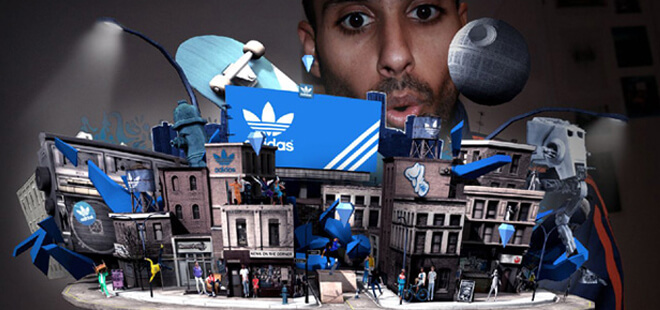Getting Involved With Augmented Reality
When I wrote about QR codes (Designed QR codes: the next level), it was very well received. When I wrote “SnapTags: Will they kill QR codes?” people got a little nasty with their suggestion on what I could do with snaptags and my mother. Now that I’m delving into Augmented Reality, I’m wondering what suggestions people will have for me… and certain family members when I insist that AR is the future of digital media?
According to Wikipedia: Augmented reality (AR) is a live, direct or indirect, view of a physical, real-world environment whose elements are augmented by computer-generated sensory input such as sound, video, graphics or GPS data. It is related to a more general concept called mediated reality, in which a view of reality is modified (possibly even diminished rather than augmented) by a computer. As a result, the technology functions by enhancing one’s current perception of reality. By contrast, virtual reality replaces the real world with a simulated one.
Augmentation is conventionally in real-time and in semantic context with environmental elements, such as sports scores on TV during a match. With the help of advanced AR technology (e.g. adding computer vision and object recognition) the information about the surrounding real world of the user becomes interactive and digitally manipulable. Artificial information about the environment and its objects can be overlaid on the real world. The term, “augmented reality” is believed to have been coined in 1990 by Thomas Caudell, working at Boeing.
Research explores the application of computer-generated imagery in live-video streams as a way to enhance the perception of the real world. AR technology includes head-mounted displays and virtual retinal displays for visualization purposes, and construction of controlled environments containing sensors and actuators.
What are Some Examples of AR?
There are many examples you can or have seen. Here’s a recent one made by Disney and displayed in Times Square:
RELATED: CIO Perspective: Undercover IT Risks
Of course, with Pixar tucked neatly into their back pockets, Disney’s AR piece is the top of technology. Appshaker, London did a really impressive AR piece for National Geographic:
So, What Does This All Mean to Your Business?
AR is another information delivery avenue via digital technology and applications are only limited by your imagination. Your business card, for instance, is a small piece of paper with your name, position, company name, address (sometimes), contact information and email/web site addresses are the old standard of information sharing in face-to-face situations, but does it sell you and your business?
Networking experts tell us we should have a 30-60 second “elevator speech’ (the time you would have with someone trapped riding in an elevator with you) where you describe what you do. Short, sweet and complete. What if you are on the ground floor or the stairs? You would get winded climbing several flights of stairs while giving your speech and the other person might run away or push you down the stairs to get rid of you. Having a business card with AR capability gives that speech for you without stutters, stammers, winded strokes or heart attacks.
RELATED: Will Google Glass Change Society for the Worst?
Let your business card do your talking as seen in these examples:
Naturally, the same application can be used for your brochures, phone directory ads, flyers, etc. Let a small printed or digital area pack a big punch with lots of information. Ikea has made great use of AR technology for several years. Starting with AR for their instruction manuals in 2010…
Ikea has now created a completely AR catalog…
http://www.youtube.com/watch?v=QQ8HNXtl7jQ
For application on packaging, AR can give consumers a view into the product…
Recognition Technology
You may have noticed that like QR codes and SnapTags, AR was tied to a small symbol for the application to work. “WAS” is the key to how the technology has evolved. Facial and image recognition is now the standard.
In a recent TED article, Matt Mills and Tamara Roukaerts demonstrate Aurasma, a new augmented reality tool that can seamlessly animate the world as seen through a smartphone. Going beyond previous augmented reality, their “auras” can do everything from making a painting talk to overlaying live news onto a printed newspaper.
RELATED: How the Dark Web and TOR Contribute to Current Privacy Concerns
Here’s examples of facial recognition via AR…
http://www.youtube.com/watch?v=F7Bn2plG_HQ
All of this comes with a price… cyber-stalking made easy is one of them but in the hands of the wrong people, which would be everyone, all of your digital information is now in the hands of everyone. It seems to be one of the dark sides of advances in technology.
Still, the technology and the GPS application has incredible information value when applied to location recognition…
How Much Does This Cost?
How much does a web site cost? How much does it cost to produce and air a commercial on TV? The question is; how much will AR save me for marketing and advertising and what kind of reach will it have?
Obviously AR technology is here to stay and will continue to evolve along with iPads, cell phones and other personal digital devices that we now rely upon in our daily lives. Like creating a web site for your business, there are financial options at both ends of the spectrum. There are the companies spotlighted in the examples in this article but there are also do-it-yourself apps you can use. It all depends on how professional an AR piece you can create. Here’s a few links to AR apps. Check them out…
http://onvert.com/
http://www.hitl.washington.edu/artoolkit/
http://blog.neonascent.net/archives/augmented-reality-code/
http://mobile.tutsplus.com/tutorials/android/android_augmented-reality/
http://www.readwriteweb.com/archives/code-free_augmented_reality_in_under_5_minutes_video.php
Top image ©KZERO Worldwide




